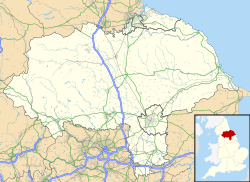History
The current building was erected on the site of the ancient guildhall of the Guild of St John the Baptist. [2] It was designed by Thomas Atkinson in the neoclassical style, built in rubble masonry with a stucco finish at a cost of £600 and was completed in 1756. [3] [4] The design involved a near symmetrical main frontage with seven bays facing onto the Market Place; the left hand section featured a doorway with Tuscan order columns supporting an entablature in the right hand bay, while the right hand section featured a rusticated archway in the central bay. The first floor was fenestrated by a row of sash windows with keystones. The ground floor of the left hand section formed a public house while the remainder of the building formed the town hall. [5] A double curving stone staircase provided access to the main assembly hall which displayed a coat of arms of King George II and extended the full width of the whole building on the first floor. [6]
A courtroom, which was situated to the rear of the assembly hall, was used for petty session hearings which were held one a fortnight. [7] A large five-sided stone porch containing a doorway with a fanlight, a hood mould and a keystone, flanked by pilasters supporting an entablature, was added to the central bay in the 19th century. [1] Following the end of the Second Boer War, a reception was held in the town hall for members of the volunteer battalions of the Green Howards who had served in South Africa. [8]
After the death of the founder of the scout movement, Lord Baden-Powell, in January 1941, his widow, Lady Baden-Powell, presented a landscape painting, depicting a view from Richmond Castle down the Swale Valley, to the town; the painting, which had originally been commissioned on the occasion of the Baden-Powells' marriage, was hung over the mantelpiece in the mayor's parlour. [4] A plaque commemorating the borough's fund raising effort during Warship Week was erected in the building in 1942. [2] Additional plaques were installed to reflect the borough's fund raising effort during Wings for Victory Week in 1943 [9] and during Salute the Soldier Week in 1944. [10]
A large reception room on the ground floor of the right-hand section of the building was refurbished and fitted out as a council chamber with new furniture supplied by Waring & Gillow in 1956. [4] An early 17th century portrait of Queen Elizabeth I on a wooden panel, which had previously hung in the Bowes Hospital at the foot of Anchorage Hill, was installed in the council chamber. [11] [12] The courtroom on the first floor remained in use as a judicial facility until 1964 when hearings moved to the new magistrates' courts in I'Anson Road. [13]
The council chamber ceased to be the local seat of government when the enlarged Richmondshire District Council was formed at Swale House in Richmond in 1974. [14] [15] [16] However, it subsequently became the meeting place of Richmond Town Council. [17] The courtroom, although no longer in use, was restored in 2002, [18] and the Prince of Wales and the Duchess of Cornwall attended a reception in the town hall in September 2005. [19] The future Chancellor of the Exchequer, Rishi Sunak, spoke at a meeting in the town hall, arranged to make the case for Brexit, in June 2016. [20]
Other works of art in the town hall include a painting by Harold Speed depicting Green Bridge, [21] a painting by Arthur Bell showing a goose fair in the town [22] and a painting by Robert Gallon depicting a view of the river. [23]
This page is based on this
Wikipedia article Text is available under the
CC BY-SA 4.0 license; additional terms may apply.
Images, videos and audio are available under their respective licenses.

